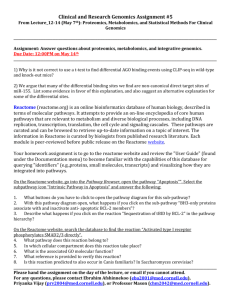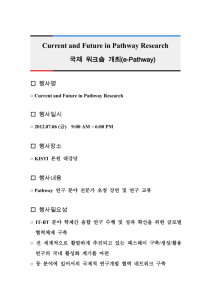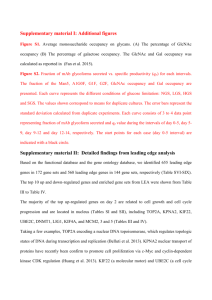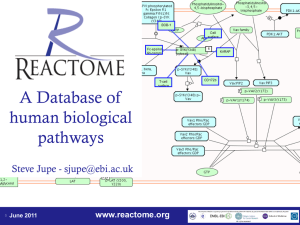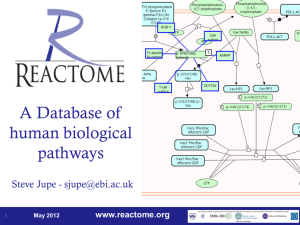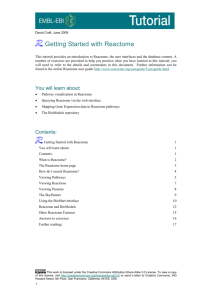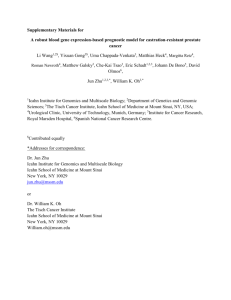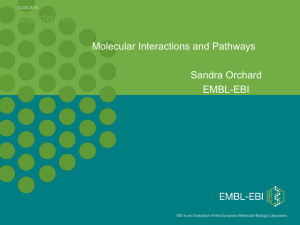Reactome Presentation
advertisement
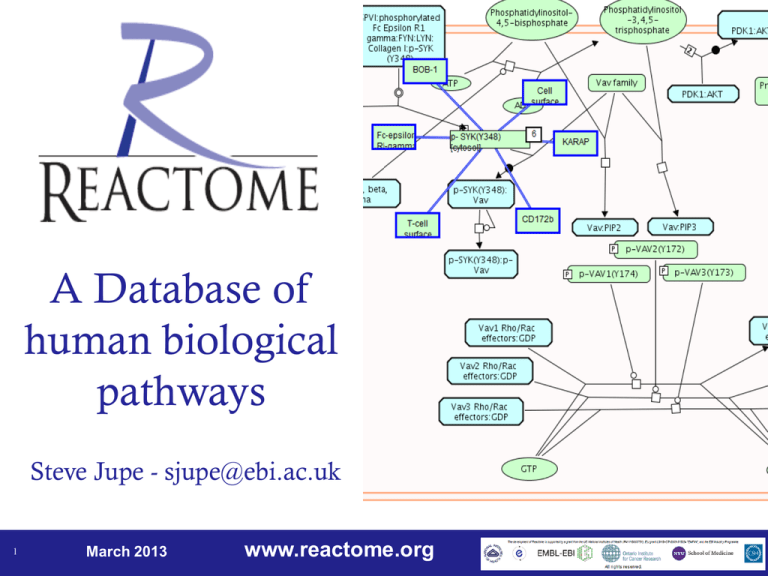
A Database of human biological pathways Steve Jupe - sjupe@ebi.ac.uk 1 March 2013 www.reactome.org Background • Cells contain thousands of molecules, – proteins and small chemical compounds • They work together to perform tasks. – provide energy – produce materials – respond to the environment. • Processes require coordinated efforts – like a factory production line. – Biologists refer to a chain of connected molecular events as a pathway. 2 March 2013 www.reactome.org ELLS 2011 Different types of pathways • Metabolic networks – provide the energy and materials • Signaling networks – sense the outside, coordinate activities within and between cells • (Gene) regulatory networks – control processes, set limits, control the molecular composition of cells 3 March 2013 www.reactome.org ELLS 2011 The scale of pathways • Early pathways were pieced together by studying biochemical reactions of individual proteins, measuring the activity, learning the substrates and products, joining them to the next enzyme in the pathway. • New technologies allow simultaneous measurement of tens of thousands of different molecules. • This reveals that many biological pathways are interconnected, more complicated than the typical textbook examples, with fluid boundaries. They can work together or against each other (feedback and regulation). 4 • Scientists who study or interpret these large scale interactions sometimes refer to the field as ‘systems biology’ • When multiple biological pathways interact = a biological network. • When all possible interactions are added, pathways become extremely difficult to understand • Biologists often work with ‘canonical’ pathways, those that represent the well-understood part of the entire network. March 2013 www.reactome.org ELLS 2011 Rationale – Journal information Nature 407(6805):770-6.The Biochemistry of Apoptosis. “Caspase-8 is the key initiator caspase in the death-receptor pathway. Upon ligand binding, death receptors such as CD95 (Apo-1/Fas) aggregate and form membranebound signalling complexes (Box 3). These complexes then recruit, through adapter proteins, several molecules of procaspase-8, resulting in a high local concentration of zymogen. The induced proximity model posits that under these crowded conditions, the low intrinsic protease activity of procaspase-8 (ref. 20) is sufficient to allow the various proenzyme molecules to mutually cleave and activate each other (Box 2). A similar mechanism of action has been proposed to mediate the activation of several other caspases, including caspase-2 and the nematode caspase CED-3 (ref. 21).” How can I access the pathway described here and reuse it? 5 March 2013 www.reactome.org Rationale - Figures A picture paints a thousand words… but…. • Just pixels • Omits key details • Assumes • Fact or Hypothesis? Nature. 2000 Oct 12;407(6805):770-6. The biochemistry of apoptosis. 6 March 2013 www.reactome.org Reactome is… Free, online, open-source curated database of pathways and reactions in human biology Authored by expert biologists, maintained by Reactome editorial staff (curators) Mapped to cellular compartment 7 March 2013 www.reactome.org Reactome is… Extensively cross-referenced Tools for data analysis – Pathway Analysis, Expression Overlay, Species Comparison, Biomart… Used to infer orthologous events in 20 other species 8 March 2013 www.reactome.org Using model organism data to build pathways – Inferred pathway events PMID:5555 Direct evidence PMID:4444 Direct evidence human PMID:8976 mouse Indirect evidence PMID:1234 cow 9 March 2013 www.reactome.org Theory - Reactions Pathway steps = the “units” of Reactome = events in biology BINDING DEGRADATION DISSOCIATION DEPHOSPHORYLATION PHOSPHORYLATION CLASSIC TRANSPORT 10 March 2013 BIOCHEMICAL www.reactome.org Reaction Example 1: Enzymatic 11 March 2013 www.reactome.org Reaction Example 2: Transport Transport of Ca++ from platelet dense tubular system to cytoplasm REACT_945.4 12 March 2013 www.reactome.org Other Reaction Types Dimerization Binding Phosphorylation 13 March 2013 www.reactome.org Reactions Connect into Pathways CATALYST CATALYST CATALYST INPUT OUTPUT INPUT OUTPUT INPUT 14 March 2013 www.reactome.org OUTPUT Evidence Tracking – Inferred Reactions Direct evidence PMID:5555 PMID:4444 Human pathway PMID:8976 Indirect evidence mouse PMID:1234 cow 15 March 2013 www.reactome.org Species Selection 16 March 2013 www.reactome.org Data Expansion – Projecting to Other Species Human B A + ATP A -P + ADP Mouse B A A -P + ADP + ATP Drosophila A + ATP B No orthologue - Protein not inferred 17 March 2013 www.reactome.org Reaction not inferred Exportable Protein-Protein Interactions Inferred from complexes and reactions (more on this later) Interactions between proteins in the same complex, reaction, or adjoining reaction Lists available from Downloads See Readme document for more details 18 March 2013 www.reactome.org Coverage – Content, TOC And many more... 19 March 2013 www.reactome.org Planned Coverage – Editorial Calendar 20 March 2013 www.reactome.org Reactome Tools • Interactive Pathway Browser • Pathway Mapping and Over-representation • Expression overlay onto pathways • Molecular Interaction overlay • Biomart 21 March 2013 www.reactome.org Tutorial Tutorial handouts in your info packages… 22 March 2013 www.reactome.org Front Page http://www.reactome.org Sidebar Navigation bar 23 Main text March 2013 www.reactome.org Exercise 1 …see the Tutorial handouts 24 March 2013 www.reactome.org The Pathway Browser Species selector Diagram Key Sidebar Zoom/move toolbar Pathway Diagram Panel Details Panel (hidden) Thumbnail 25 March 2013 www.reactome.org Pathways tab – pathway hierarchy Pathway Reaction Black-box 26 March 2013 www.reactome.org Exercise 2 …see the Tutorial handouts From the homepage, search for ‘PDGF signaling’. Click on the top pathway hit. This will open it in the Pathway Browser. Ignoring the diagram for now, look at the Pathways tab on the left. 1. How many sub-pathways does this pathway have? 2. How many reactions are in the first of these sub-pathways? 3. What reaction follows Processing of classical PDGFs? Hint: If it’s not visible, open the Details pane at the bottom of the page by clicking on the blue triangle. 27 March 2013 www.reactome.org The Pathway Browser - Pathway Diagrams Boxes are proteins, protein sets, mixed sets or complexes. Ovals are small molecules (or sets of) Green boxes are proteins or sets, blue are complexes. Regulation +ve -ve Input Reaction node Catalyst Outputs Compartment Transition 28 March 2013 Binding Dissociation Omitted www.reactome.org Uncertain Exercise 3 …see the Tutorial handouts 29 March 2013 www.reactome.org Navigating in the Pathway Browser I Home and Analyze buttons Click here Highlights Details here Click here to open pathway diagram... 30 March 2013 www.reactome.org Navigating in the Pathway Browser II Click here Highlights Zoom Details here 31 March 2013 www.reactome.org Exercise 4 …see the Tutorial handouts 32 March 2013 www.reactome.org The Details Panel 33 March 2013 www.reactome.org Exercise 5 …see the Tutorial handouts 34 March 2013 www.reactome.org Pathway Analysis 35 March 2013 www.reactome.org Pathway Analysis – Overrepresentation P-val Reveal next level 36 ‘Top-level’ March 2013 www.reactome.org Exercise 6 …see the Tutorial handouts Check this! 37 March 2013 www.reactome.org Species Comparison I 38 March 2013 www.reactome.org Species Comparison II Yellow = human/rat Blue = human only Grey = not relevant Black = Complex 39 March 2013 www.reactome.org Exercise 7 …see the Tutorial handouts 40 March 2013 www.reactome.org Expression Analysis I 41 March 2013 www.reactome.org Expression Analysis II Step through Data columns 42 March 2013 www.reactome.org ‘Hot’ = high ‘Cold’ = low Exercise 8 43 March 2013 www.reactome.org Molecular Interaction Overlay 44 March 2013 www.reactome.org Exercise 9 …see the Tutorial handouts 45 March 2013 www.reactome.org New Look Browser 46 March 2013 www.reactome.org End 47 March 2013 www.reactome.org BioMart – selecting your dataset 48 March 2013 www.reactome.org BioMart – filters 49 March 2013 www.reactome.org BioMart – attributes Check to get attribute 50 March 2013 www.reactome.org BioMart – results 51 March 2013 www.reactome.org Exercise 10 52 March 2013 www.reactome.org
